publications
publications by categories in reversed chronological order. generated by jekyll-scholar.
2025
-
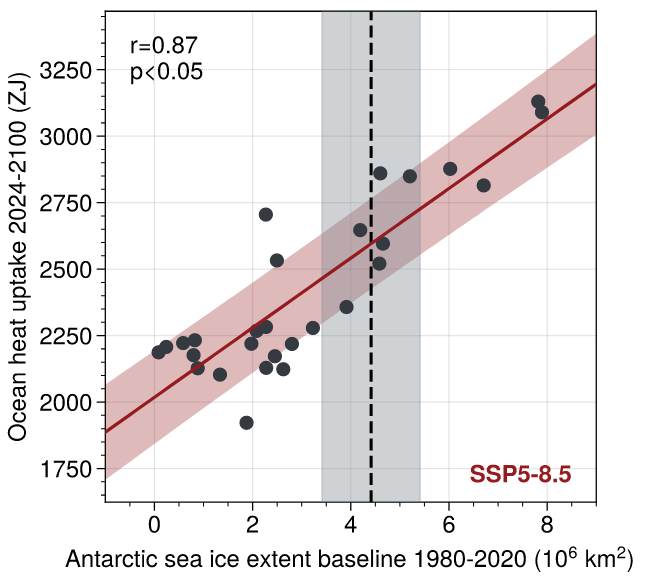 Increased future ocean heat uptake constrained by Antarctic sea ice extentLinus Vogt, Casimir Lavergne, Jean-Baptiste Sallée, Lester Kwiatkowski, and 2 more authorsEarth System Dynamics, Oct 2025
Increased future ocean heat uptake constrained by Antarctic sea ice extentLinus Vogt, Casimir Lavergne, Jean-Baptiste Sallée, Lester Kwiatkowski, and 2 more authorsEarth System Dynamics, Oct 2025The ocean takes up over 90 % of the excess heat stored in the Earth system as a result of anthropogenic climate change, which has led to sea level rise and an intensification of marine extreme events. However, despite their importance for informing climate policy, future ocean heat uptake (OHU) projections still strongly differ between climate models. Here, we provide improved global OHU projections by identifying a relationship between present-day Antarctic sea ice extent (SIE) and future OHU across an ensemble of 28 state-of-the-art climate models. Models with more sea ice at present also simulate a colder Southern Hemisphere climate state in general, allowing a larger shift in atmospheric and ocean warming. This regional change affects global warming and heat uptake via a northward-propagating cloud feedback. Combining this relationship between historical Antarctic sea ice extent and future global OHU with satellite observations of Antarctic sea ice reduces the uncertainty of OHU projections under future emission scenarios by 12 %–33 %. Moreover, we show that an underestimation of present-day Antarctic sea ice in the latest generation of climate models results in an underestimation of future OHU by 3 %–14 %, an underestimation of global cloud feedback by 19 %–32 %, and an underestimation of global atmospheric warming by 6 %–7 %. This emergent constraint is based on a strong coupling between Antarctic sea ice, deep-ocean temperatures, and Southern Hemisphere sea surface temperatures and cloud cover in climate models. Our study reveals how the present-day Southern Ocean state impacts future climate change and suggests that previous constraints based on warming trends over recent decades have underestimated future warming and ocean heat uptake.
-
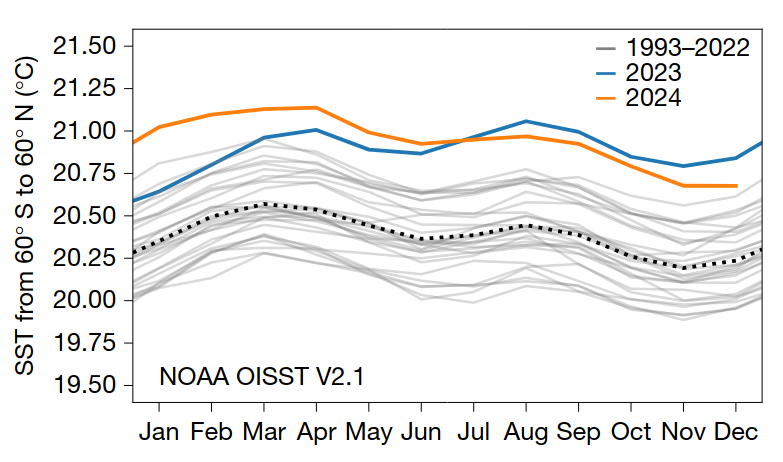 Record sea surface temperature jump in 2023–2024 unlikely but not unexpectedJens Terhaar, Friedrich A. Burger, Linus Vogt, Thomas L. Frölicher, and 1 more authorNature, Mar 2025
Record sea surface temperature jump in 2023–2024 unlikely but not unexpectedJens Terhaar, Friedrich A. Burger, Linus Vogt, Thomas L. Frölicher, and 1 more authorNature, Mar 2025Global ocean surface temperatures were at record levels for more than a year from April 2023 onwards, exceeding the previous record in 2015–2016 by 0.25 °C on average between April 2023 and March 20241. The nearly global extent and unprecedented intensity of this event prompted questions about how exceptional it was and whether climate models can represent such record-shattering jumps in surface ocean temperatures2. Here we construct observation-based synthetic time series to show that a jump in global sea surface temperatures that breaks the previous record by at least 0.25 °C is a 1-in-512-year event under the current long-term warming trend (1-in-205-year to 1-in-1,185-year event; 95% confidence interval). Without a global warming trend, such an event would have been practically impossible. Using 270 simulations from a wide range of fully coupled climate models, we show that these models successfully simulate such record-shattering jumps in global ocean surface temperatures, underpinning the models’ usefulness in understanding the characteristics, drivers and consequences of such events. These model simulations suggest that the record-shattering jump in surface ocean temperatures in 2023–2024 was an extreme event after which surface ocean temperatures are expected to revert to the expected long-term warming trend.
-
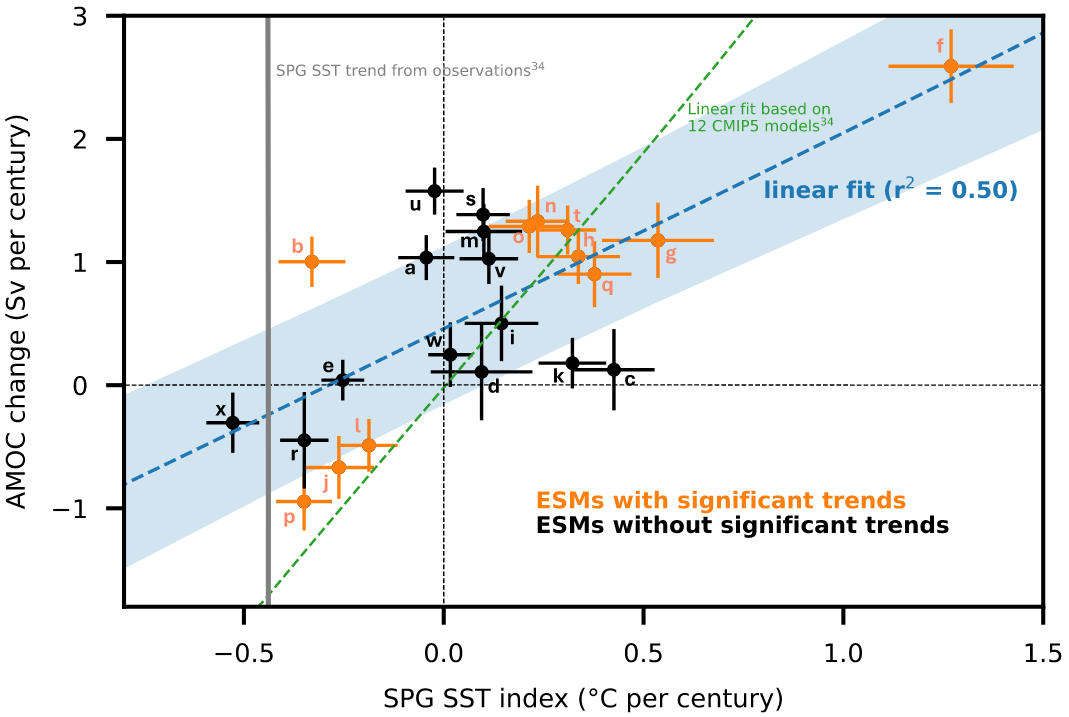 Atlantic overturning inferred from air-sea heat fluxes indicates no decline since the 1960sJens Terhaar, Linus Vogt, and Nicholas P. FoukalNature Communications, Jan 2025
Atlantic overturning inferred from air-sea heat fluxes indicates no decline since the 1960sJens Terhaar, Linus Vogt, and Nicholas P. FoukalNature Communications, Jan 2025The Atlantic Meridional Overturning Circulation (AMOC) is crucial for global ocean carbon and heat uptake, and controls the climate around the North Atlantic. Despite its importance, quantifying the AMOC’s past changes and assessing its vulnerability to climate change remains highly uncertain. Understanding past AMOC changes has relied on proxies, most notably sea surface temperature anomalies over the subpolar North Atlantic. Here, we use 24 Earth System Models from the Coupled Model Intercomparison Project Phase 6 (CMIP6) to demonstrate that these temperature anomalies cannot robustly reconstruct the AMOC. Instead, we find that air-sea heat flux anomalies north of any given latitude in the North Atlantic between 26.5°N and 50°N are tightly linked to the AMOC anomaly at that latitude on decadal and centennial timescales. On these timescales, air-sea heat flux anomalies are strongly linked to AMOC-driven northward heat flux anomalies through the conservation of energy. On annual timescales, however, air-sea heat flux anomalies are mostly altered by atmospheric variability and less by AMOC anomalies. Based on the here identified relationship and observation-based estimates of the past air-sea heat flux in the North Atlantic from reanalysis products, the decadal averaged AMOC at 26.5°N has not weakened from 1963 to 2017 although substantial variability exists at all latitudes.
-
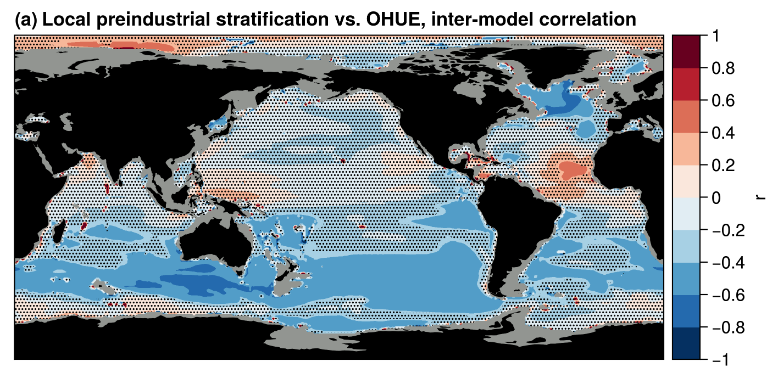 Stratification and overturning circulation are intertwined controls on ocean heat uptake efficiency in climate modelsLinus Vogt, Jean-Baptiste Sallée, and Casimir LavergneOcean Science, Jun 2025
Stratification and overturning circulation are intertwined controls on ocean heat uptake efficiency in climate modelsLinus Vogt, Jean-Baptiste Sallée, and Casimir LavergneOcean Science, Jun 2025The global ocean takes up over 90 % of the excess heat added to the climate system due to anthropogenic emissions, thereby buffering climate change at Earth’s surface. A key metric for quantifying the role of the oceanic processes removing this heat from the atmosphere and storing it in the ocean is the ocean heat uptake efficiency (OHUE), defined as the amount of ocean heat uptake per degree of global surface warming. Despite the importance of OHUE, there remain substantial uncertainties concerning the physical mechanisms controlling its magnitude in global climate model simulations: ocean mixed-layer depth, Atlantic Meridional Overturning Circulation (AMOC) strength, and upper-ocean stratification strength have all been previously proposed as controlling factors. In this study, we analyze model output from an ensemble of 28 climate models from the Coupled Model Intercomparison Project, Phase 6 (CMIP6), in order to resolve these apparently divergent explanations. We find that stratification in the mid-latitude Southern Ocean is a key model property setting the value of OHUE due to its influence on Southern Ocean overturning. The previously proposed role of the AMOC in OHUE is explained by a link between stratification model biases in the subpolar North Atlantic and the Southern Ocean. Our analysis thus reconciles previous attempts at explaining controls on OHUE and highlights the importance of interlinked model biases across variables and geographical regions.
2024
-
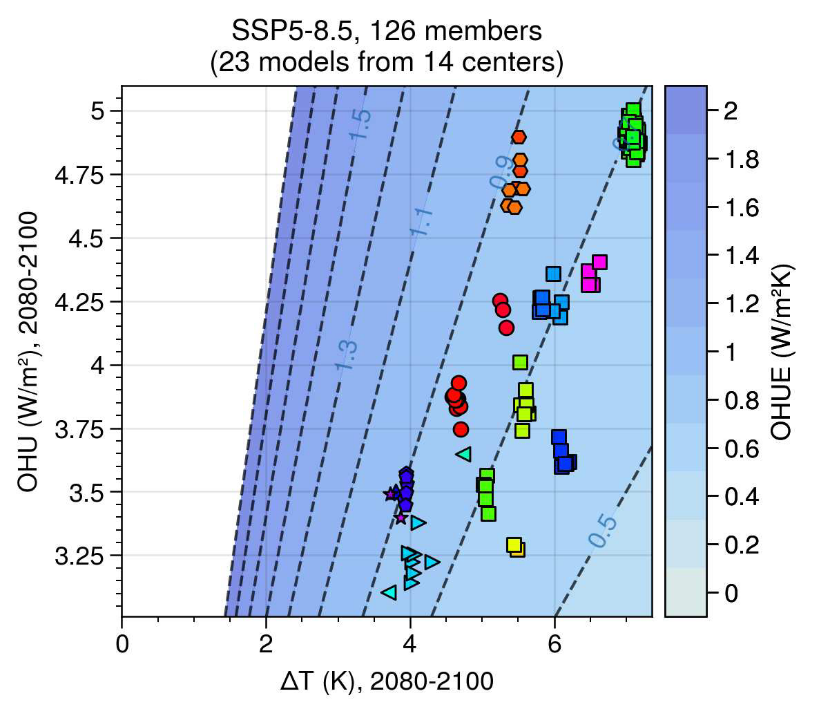 The role of the upper ocean for global ocean heat uptake and climateLinus VogtSorbonne Université, Dec 2024Ph.D. thesis
The role of the upper ocean for global ocean heat uptake and climateLinus VogtSorbonne Université, Dec 2024Ph.D. thesisThe Earth’s climate is currently undergoing rapid and widespread changes. Human activities in the industrial era, in particular the emission of CO2 into the atmosphere through the burning of fossil fuels, have led to an enhanced greenhouse effect which has caused an increase in the global average surface air temperature of 1.1°C in 2011-2020 relative to 1850-1900. A further consequence is the warming of the global ocean: it has absorbed over 90% of the excess energy stored in the Earth system due to the increased radiative forcing. This global ocean heat uptake (OHU) is a critical climate process and plays a dual role for anthropogenic climate change. On the one hand, OHU is a measure of the cumulative effects of transient climate change, and scales with negative impacts such as sea level rise and the frequency of oceanic extreme events. On the other hand, OHU provides a crucial service by shielding the atmosphere from large amounts of heat that would otherwise cause much greater global warming than currently observed. Despite their importance, many of the physical processes controlling OHU are still poorly understood, including in state-of-the-art numerical climate models used for international climate change assessments. In this thesis, we address this problem using climate simulations of models participating in the Coupled Model Intercomparison Project (CMIP). In a first study, we provide improved future projections of global OHU by the end of the 21st century by identifying an emergent relationship across an ensemble of CMIP models linking the simulated baseline climate state of the Southern Hemisphere to future global OHU. By combining this relationship with observational data, we obtain constrained projections showing that future OHU is likely larger than previously thought. In a second study, we clarify the processes involved in setting the ocean heat uptake efficiency (OHUE) which quantifies the amount of OHU per degree of global surface warming. We reconcile a number of previous attempts at explaining controls on OHUE, and show that the upper ocean stratification in the Southern Ocean is a key property setting its value in CMIP climate models. Last, we present an exploratory analysis combining the approaches of these two studies, and perform a statistical analysis of simulations from a large multi-model ensemble with the goal of constraining OHUE. Beyond these concrete results concerning global OHU, we also discuss some of the methodological issues related to the interpretation of uncertainties arising from multi-model ensembles more generally.
2023
-
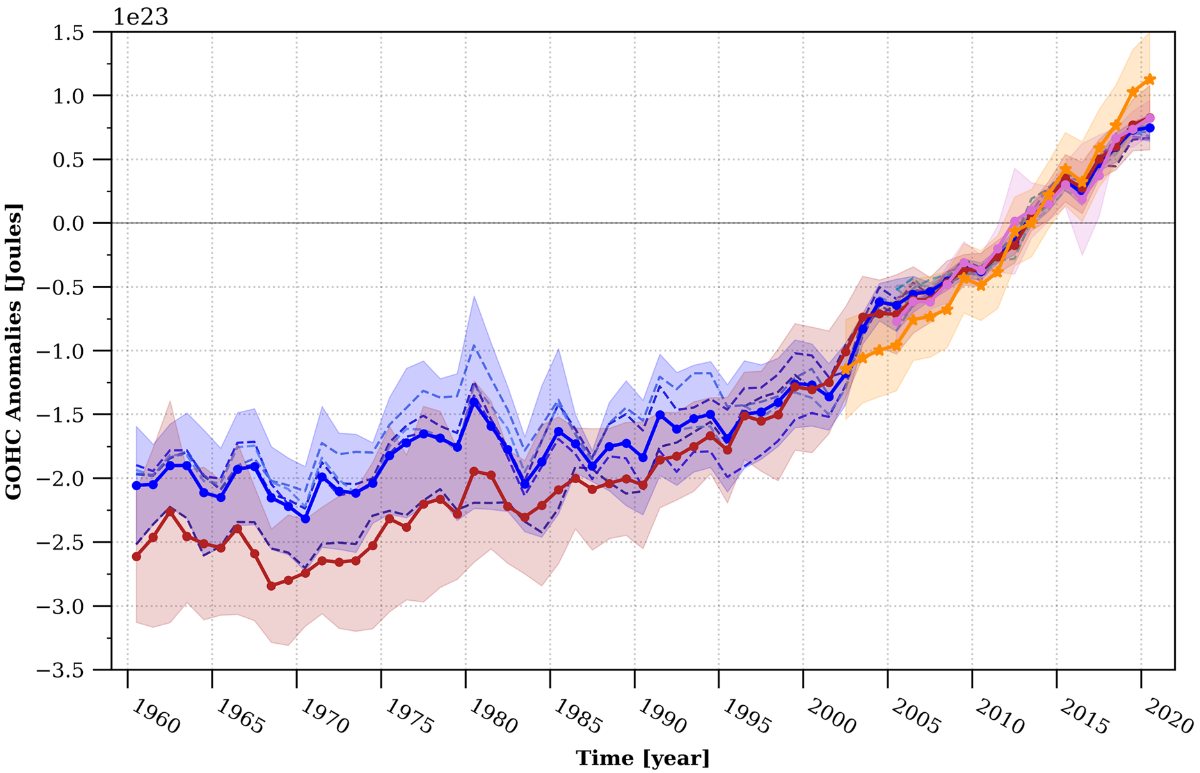 Robust acceleration of Earth system heating observed over the past six decadesAudrey Minière, Karina Schuckmann, Jean-Baptiste Sallée, and Linus VogtScientific Reports, Dec 2023
Robust acceleration of Earth system heating observed over the past six decadesAudrey Minière, Karina Schuckmann, Jean-Baptiste Sallée, and Linus VogtScientific Reports, Dec 2023Global heating of the Earth system is unequivocal. However, detecting an acceleration of Earth heating has remained elusive to date, despite suggestive evidence of a potential increase in heating rates. In this study, we demonstrate that since 1960, the warming of the world ocean has accelerated at a relatively consistent pace of 0.15 ± 0.05 (W/m2)/decade, while the land, cryosphere, and atmosphere have exhibited an accelerated pace of 0.013 ± 0.003 (W/m2)/decade. This has led to a substantial increase in ocean warming, with a magnitude of 0.91 ± 0.80 W/m2 between the decades 1960–1970 and 2010–2020, which overlies substantial decadal-scale variability in ocean warming of up to 0.6 W/m2. Our findings withstand a wide range of sensitivity analyses and are consistent across different observation-based datasets. The long-term acceleration of Earth warming aligns qualitatively with the rise in CO2 concentrations and the decline in aerosol concentration during the same period, but further investigations are necessary to properly attribute these changes.
-
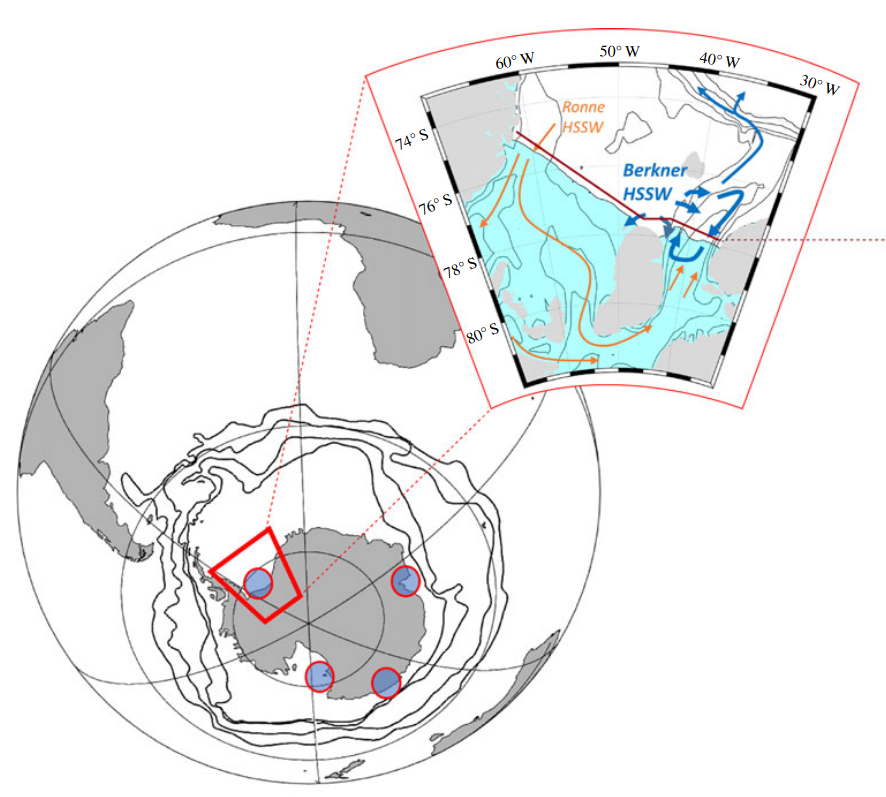 Southern ocean carbon and heat impact on climateSO-CHIC Consortium, J. B. Sallée, E. P. Abrahamsen, C. Allaigre, and 50 more authorsPhilosophical Transactions of the Royal Society A: Mathematical, Physical and Engineering Sciences, May 2023
Southern ocean carbon and heat impact on climateSO-CHIC Consortium, J. B. Sallée, E. P. Abrahamsen, C. Allaigre, and 50 more authorsPhilosophical Transactions of the Royal Society A: Mathematical, Physical and Engineering Sciences, May 2023The Southern Ocean greatly contributes to the regulation of the global climate by controlling important heat and carbon exchanges between the atmosphere and the ocean. Rates of climate change on decadal timescales are therefore impacted by oceanic processes taking place in the Southern Ocean, yet too little is known about these processes. Limitations come both from the lack of observations in this extreme environment and its inherent sensitivity to intermittent processes at scales that are not well captured in current Earth system models. The Southern Ocean Carbon and Heat Impact on Climate programme was launched to address this knowledge gap, with the overall objective to understand and quantify variability of heat and carbon budgets in the Southern Ocean through an investigation of the key physical processes controlling exchanges between the atmosphere, ocean and sea ice using a combination of observational and modelling approaches. Here, we provide a brief overview of the programme, as well as a summary of some of the scientific progress achieved during its first half. Advances range from new evidence of the importance of specific processes in Southern Ocean ventilation rate (e.g. storm-induced turbulence, sea–ice meltwater fronts, wind-induced gyre circulation, dense shelf water formation and abyssal mixing) to refined descriptions of the physical changes currently ongoing in the Southern Ocean and of their link with global climate. This article is part of a discussion meeting issue ‘Heat and carbon uptake in the Southern Ocean: the state of the art and future priorities’.
2022
-
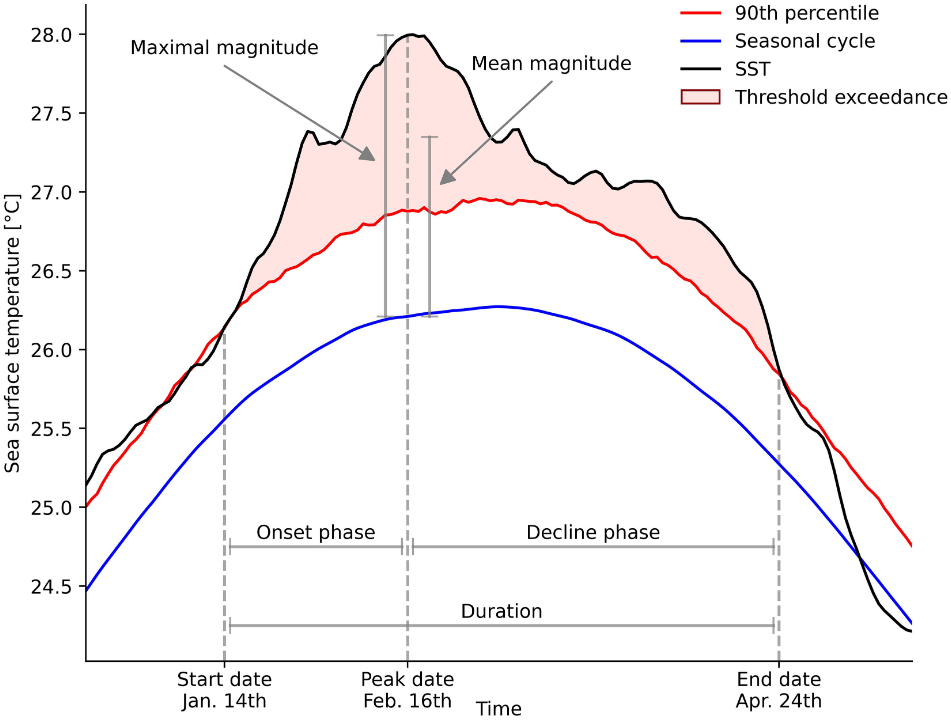 Local Drivers of Marine Heatwaves: A Global Analysis With an Earth System ModelLinus Vogt, Friedrich A. Burger, Stephen M. Griffies, and Thomas L. FrölicherFrontiers in Climate, May 2022
Local Drivers of Marine Heatwaves: A Global Analysis With an Earth System ModelLinus Vogt, Friedrich A. Burger, Stephen M. Griffies, and Thomas L. FrölicherFrontiers in Climate, May 2022Marine heatwaves (MHWs) are periods of extreme warm ocean temperatures that can have devastating impacts on marine organisms and socio-economic systems. Despite recent advances in understanding the underlying processes of individual events, a global view of the local oceanic and atmospheric drivers of MHWs is currently missing. Here, we use daily-mean output of temperature tendency terms from a comprehensive fully coupled coarse-resolution Earth system model to quantify the main local processes leading to the onset and decline of surface MHWs in different seasons. The onset of MHWs in the subtropics and mid-to-high latitudes is primarily driven by net ocean heat uptake associated with a reduction of latent heat loss in all seasons, increased shortwave heat absorption in summer and reduced sensible heat loss in winter, dampened by reduced vertical mixing from the non-local portion of the K-Profile Parameterization boundary layer scheme (KPP) especially in summer. In the tropics, ocean heat uptake is reduced and lowered vertical local mixing and diffusion cause the warming. In the subsequent decline phase, increased ocean heat loss to the atmosphere due to enhanced latent heat loss in all seasons together with enhanced vertical local mixing and diffusion in the high latitudes during summer dominate the temperature decrease globally. The processes leading to the onset and decline of MHWs are similar for short and long MHWs, but there are differences in the drivers between summer and winter. Different types of MHWs with distinct driver combinations are identified within the large variability among events. Our analysis contributes to a better understanding of MHW drivers and processes and may therefore help to improve the prediction of high-impact marine heatwaves.